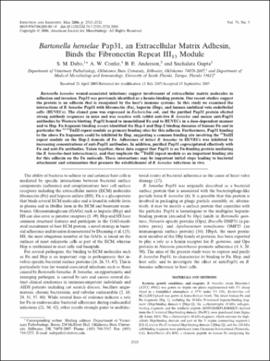| dc.contributor.author | Dabo, S. M. | |
| dc.contributor.author | Confer, A. W. | |
| dc.contributor.author | Anderson, B. E. | |
| dc.contributor.author | Gupta, Snehalata | |
| dc.date.accessioned | 2015-10-16T20:47:55Z | |
| dc.date.available | 2015-10-16T20:47:55Z | |
| dc.date.issued | 2006-05 | |
| dc.identifier | okds_Confer_IAI_2006-05.pdf | |
| dc.identifier.citation | Dabo, S. M., Confer, A. W., Anderson, B. E., & Gupta, S. (2006). Bartonella henselae Pap31, an extracellular matrix adhesin, binds the fibronectin repeat III13 module. Infection and Immunity, 74(5), 2513-2521. https://doi.org/10.1128/iai.74.5.2513-2521.2006 | |
| dc.identifier.uri | https://hdl.handle.net/11244/19814 | |
| dc.description.abstract | Bartonella henselae wound-associated infections suggest involvement of extracellular matrix molecules in adhesion and invasion. Pap31 was previously identified as a hemin-binding protein. Our recent studies suggest the protein is an adhesin that is recognized by the host's immune systems. In this study we examined the interactions of B. henselae Pap31 with fibronectin (Fn), heparin (Hep), and human umbilical vein endothelial cells (HUVECs). The cloned gene was expressed in Escherichia coli, and the purified Pap31 protein elicited strong antibody responses in mice and was reactive with rabbit anti-live B. henselae and mouse anti-Pap31 antibodies by Western blotting. Pap31 bound to immobilized Fn and to HUVECs in a dose-dependent manner and to Hep. Fn fragment-binding assays identified the Hep-1 and Hep-2 binding domains of human Fn and in particular the 12-13FnIII repeat module as primary binding sites for this adhesin. Furthermore, Pap31 binding to the above Fn fragments could be inhibited by Hep, suggesting a common binding site involving the 13FnIII repeat module on the Hep-2 domain of Fn. Adherence of intact B. henselae to HUVECs was inhibited by increasing concentrations of anti-Pap31 antibodies. In addition, purified Pap31 coprecipitated effectively with Fn and anti-Fn antibodies. Taken together, these data suggest that Pap31 is an Fn-binding protein mediating the B. henselae-host interaction(s), and they implicate the 13FnIII repeat module as an important binding site for this adhesin on the Fn molecule. These interactions may be important initial steps leading to bacterial attachment and colonization that promote the establishment of B. henselae infections in vivo. | |
| dc.format | application/pdf | |
| dc.language | en_US | |
| dc.publisher | American Society for Microbiology | |
| dc.rights | This material has been previously published. In the Oklahoma State University Library's institutional repository this version is made available through the open access principles and the terms of agreement/consent between the author(s) and the publisher. The permission policy on the use, reproduction or distribution of the material falls under fair use for educational, scholarship, and research purposes. Contact Digital Resources and Discovery Services at lib-dls@okstate.edu or 405-744-9161 for further information. | |
| dc.title | Bartonella henselae Pap31, an extracellular matrix adhesin, binds the fibronectin repeat III13 module | |
| osu.filename | okds_Confer_IAI_2006-05.pdf | |
| dc.description.peerreview | Peer reviewed | |
| dc.identifier.doi | 10.1128/IAI.74.5.2513-2521.2006 | |
| dc.description.department | Veterinary Pathobiology | |
| dc.type.genre | Article | |
| dc.type.material | Text | |
